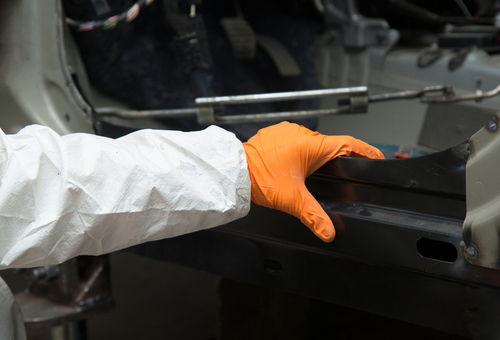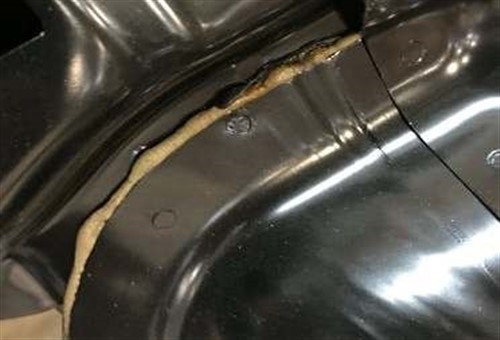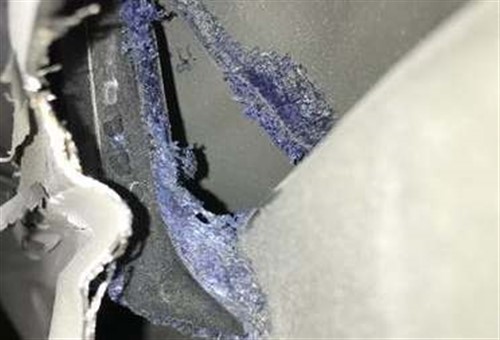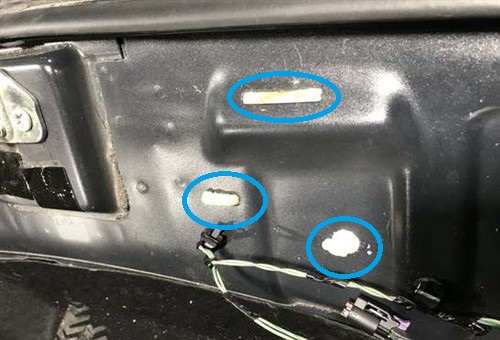
This writer was recently invited by an erstwhile colleague to consult on an NVH issue on a 2019 Toyota Camry that proved very difficult to pin down or identify. Somewhat intrigued, this writer fully expected to find a run-of-the-mill sort of problem on a bog-standard Camry: he expected to diagnose something like a rumbling wheel bearing, or the exhaust system banging against something, or maybe a worn control arm bushing, but that was not to be.
Instead, this writer encountered a vehicle with NVH issues that were so weird and surreal that it had likely never happened before in the history of motor vehicles- and will likely never happen again. So, in this article, we recount the tale of a 2019 Toyota Camry’s seemingly un-diagnosable NVH issue on the one hand, and why not having professional collision repairers perform structural body repairs on a late-model car is a bad idea, on the other. Let us start by stating-
When this writer arrived at the shock absorber/exhaust/tyre fitment establishment where the car was, he found something that seemed to have jumped straight out of the pages of a glossy car culture magazine. In fact, it was not immediately recognizable as a Toyota Camry. Here is a brief description of the car-
It was painted a striking pearlescent red and sported a somewhat flashy body kit that included flared wheel arches filled with 19-inch alloy rims and ultra-low-profile tyres that looked more like rim protectors than tyres. Closer inspection revealed competition-grade adjustable coil-over shock absorbers on the rear axle and competition-grade adjustable gas struts on the front wheels. The rear wheels now featured ventilated disc brakes, while the front wheels featured outsized ventilated discs and Brembo callipers. The work order included the note that the ABS and cruise control systems had been disabled/removed and deleted from the ECU by a specialist tuning company.
Other modifications included a sequential turbocharger setup connected to the (now) highly modified 2.5L engine with convoluted ducting, an aftermarket air filter, a non-standard radiator with two huge electric cooling fans, and a water-cooled intercooler built into the space where the A/C condenser used to live. The exhaust system turned out to be a custom-designed, tuned-length stainless steel system. The catalytic converter followed immediately after the custom made scavenging header, and a largish silencer completed the set-up.
We might also mention that the body kit was fibre-glassed onto the bodywork, the front seats featured five-point harnesses, while the rest of the interior was finished in black Alcantara fabric and custom-made plush carpeting, which brings us to-
According to the owner of the fitment centre, the car belonged to a regular customer of his, a retired corporate attorney, who’d bought it at an auction when the original owner decided to get rid of it after a minor accident. With much experience of restoring classic cars to what can best be described as "better-than-new" condition, the customer was experiencing somewhat of a midlife crisis, so, to assuage the symptoms, he decided to buy the car and fix the accident damage himself as part of a project to turn the car into something resembling the flashy cars one sees in car-culture inspired movies.
As it turned out, the project was hugely expensive, took almost two years to complete, and officially ended about two weeks before this consultation, which was the first time the customer drove the vehicle on a public road. It was during this test drive that the customer became aware of (as he put it) a rumbling, grumbling, roaring noise that started to pulsate whenever he exceeded about 80km/h. At speeds below 80km/h, the sound was just at the threshold of human hearing, but both the sound and the frequency at which it pulsated above 80km/h increased almost linearly as the vehicles’ speed increased. Worse, the sound also appeared at some engine speeds while the vehicle was stationary.
In efforts to identify the source of the noise, the car's owner drove it at different speeds on roads with different surfaces; drove it with different tyre pressures, and then drove it with varying numbers of passengers in the car to see if different loads in the car had any effect on the noise. These experiments yielded inconclusive results because while the noise varied somewhat under different conditions, it never went away. The next experiment involved swopping the wheels around and replacing the rubber exhaust hangers with more sturdy, less resilient ones but the result was the same; the noise varied, but never went away.
As a last resort, he removed the flywheel/clutch assembly and had its balance checked by a firm that specialised in balancing rotating assemblies. It turned out that the flywheel and clutch assembly was balanced perfectly, so he re-installed the engine but this time, he replaced the standard engine mounts with competition-grade oil-filled mounts to be sure the engine did not cause or contribute to the NVH issue. The hugely expensive engine mounts made no difference, however.
Finally conceding defeat, the Camry's owner approached the fitment centre and asked them to “have a look” since they not only supplied the tyres, but also designed, fabricated, and fitted the exhaust system. The fitment centre's owner agreed and took the car for a long test drive to verify the problem, which according to him, was unlike anything he’d ever heard or experienced in any car before.
According to the fitment centre’s owner, at 130km/h, the whole car started to vibrate in a manner that produced an almost visceral reaction in him, but it was not as if the car was breaking apart: it was more like a high-pitched vibration that produced an almost tingling sensation all over his body.
Taken together, the number and nature of the modifications on this Camry offered a great many possible sources of knocking, thudding, and whistling noises, but no such noises were present when this writer went on a test drive with the owner of the fitment centre. This writer did, however, hear the same kind of pulsating noise the car's owner did and experienced the same high-pitched vibration the fitment centre's owner did, which brings us to-
If the truth were told, this writer had also never heard or experienced anything like the noise and vibration this Camry produced. Nonetheless, based on the assumption that every problem has a solution, this writer fetched his advanced NVH detection kit*and placed eight microphones around the vehicle's interior, all of which fed into an adapted laptop computer that was, in fact, an industrial-grade oscilloscope in disguise. The oscilloscope had twelve channels, so we placed four accelerometers in likely places around the interior of the vehicle as well, and connected them to the remaining four channels. Next, we verified that the tyres were inflated correctly, and set out on another test drive.
* This kit previously belonged to a retired mechanical engineer who used it to identify vibrations on large rotating components like aircraft engines and power station turbines.
The results were instructive, to say the least. Sadly, we cannot reproduce the original waveforms here, but suffice to say that at 60km/h, the microphones all began to record essentially the same waveform. While the amplitude of the waveforms (from some of the microphones) differed somewhat between microphones, the overall sine-wave shapes of all the waveforms were essentially identical. At 80km/h, when the sound became audible, the amplitudes of the sound waveforms from all the microphones became more uniform, and at 120km/h, the frequencies of some waveforms almost doubled while some microphones began recording resonating frequencies, i.e., secondary wave peaks that were superimposed on the base frequency.
For reasons that are still unclear, the accelerometers recorded what could be termed "flat lines" but that was not really important- what was important was that the entire structure of this Camry appeared to be vibrating like a guitar string. It was not just strange- it was utterly surreal and had likely never happened before in the history of motor cars.
Nonetheless, now that we knew what we were dealing with, we had to figure out what was causing it, so we sat down to start-
At the time, we thought that the large wheels and low profile tyres might contribute to the vibration issue, but we could not run the vehicle with standard wheels because the standard rims would not have fitted over the outsized brakes. Secondly, we could not remove the body kit because it was permanently affixed to the bodywork.
With the two most likely causes off the table, so to speak, we considered removing the exhaust system and doing another test drive, but we were not entirely convinced that the exhaust system was a major contributing factor. At this point, we were out of options, but then we remembered that the customer mentioned the fact that the weird noise and vibrations also appeared at some engine speeds when the vehicle was stationary.
This looked like a promising avenue to explore, so we used the oscilloscope and a single microphone to pinpoint the origin of the vibrations while an assistant raised the engine speed in small increments. By moving the microphone around the interior of the car, we found the most pronounced vibrations occurred with the engine running at 3 200 RPM. We measured the frequency at 22 Hz (just above the lower threshold of human hearing) around the sill area on the left of the vehicle. Keeping the engine speed steady at 3 200 RPM, we discovered that the frequency of the vibrations increased to 25 Hz both towards the centre, and the front of the interior until it peaked at just over 30 Hz at the firewall.
It is perhaps worth mentioning that all the doors were open during this exercise, so on a whim, we decided to leave the microphone on the floor at the firewall and closed the doors. The result was dramatic and immediate; the frequency of the vibration increased to more than 70 Hz, and resonating frequencies appeared almost immediately. We did not expect this, but the only conclusion(s) that made sense was that closing the doors somehow "tightened" the structure of the car and that the closed doors acted like soundboards that amplified the vibrations.
This discovery represented both good and bad news. The good news was that the wheels and exhaust system were almost certainly not the primary causes of the problem, but the really bad news was that we had no idea how to identify the root cause(s) of the problem. We can skip over the details of the discussions and speculations that followed, but in the end, we decided that it was-
The only thing that kind of made sense to us was the notion that the owner of the problem Camry had somehow got things wrong when he repaired the accident damage on the car, so the expert we decided to call upon was a local collision repairer both of us knew, and for whom we had done mechanical repairs before.
Since this person was accredited with several major manufacturers to perform accident and corrosion repair, as well as painting to factory standards, he grasped the problem immediately when we explained what we had found. He agreed to come over immediately.
When he arrived at the fitment centre, we showed him our recorded scope traces, which he studied for a few minutes. Next thing, he pulled a little plastic mallet out of his pocket, walked over to the car, and started tapping the area where the fibreglass body kit joined the sill on the left-hand side of the car. Next, he got down on the floor and started tapping the underside of the floor towards the middle of the car, which he followed up by pulling up the carpet and tapping along the inside of the sill towards the firewall.
Neither of us had seen this type of diagnostics before, but the collision repairer’s verdict was swift and sure. Here is what he said-
Foam? What foam? We can skip over the details of this discussion also, but the gist of it was that tapping the car with the little mallet revealed not only the welded joints in the sill, floor and firewall but also the fact that the various types of foam that suppressed vibration and contributed to the vehicle's structural strength were missing from the repaired areas.
All we knew was that the customer had repaired the accident damage on a DIY basis, but we did not know the extent of the accident damage or exactly what had been repaired. Thus, to confirm his diagnosis, the collision repairer called up the customer and asked him for details on the damage and how he had repaired it.
It turned out that the collision repairer was right. The customer told him that he had cut out the entire sill on the left-hand side, as well as about half of the floor and a section of the lower part of the firewall on the left-hand side. He also said he sourced the sill from a Toyota dealership, but the parts of the floor and firewall he'd replaced were donated by an undamaged body shell he’d found at a salvage yard.
The details of the actual repair are not relevant here, but suffice to say that when we put the car on a lift, the collision repairer showed us where the car had been cut, and the new parts welded in. While the repair had been done extremely neatly, the collision repairer pointed out a few things, these being that-
The collision repairer continued his lecture by saying that the primary reason why modern vehicles are as quiet and free of vibrations as they are is that manufacturers now inject or place various kinds of foam into hundreds of places in car bodies that most people, including mechanics, don't know exist. For the most part, manufacturers use three kinds of foam for three different purposes; to suppress vibration, to suppress or absorb road-noise, and to increase the structural strength of welded joints.
To demonstrate this, the collision repairer pulled up some pictures from his phone, so consider the examples of OEM-installed foam shown below-

Image source: https://www.vehicleservicepros.com/collision-repair/on-the-shop-floor/article/21240452/automotive-foams
The whitish substance we see protruding here is neither an adhesive nor a sealant. This is an example of structural foam that is added during the manufacturing process. In this case, the foam is placed between the plates forming the transmission tunnel and the firewall before the two parts are welded together. While the problem Camry did not have a transmission tunnel, its firewall is strengthened by similar foam both between it and the cars' side panels and between the several plates that make up the firewall.

Image source: https://www.vehicleservicepros.com/collision-repair/on-the-shop-floor/article/21240452/automotive-foams
The blue foam in this example is intended to damp out vibrations in a rear quarter panel on a Jeep Cherokee. In this case, the panel was torn open during an accident, and while the damage is repairable in this instance, the only reliable repair involves replacing the entire panel since getting the placement of the foam wrong can cause annoying, if not always severe vibrations in the vehicle’s rear hatch.

Image source: https://www.vehicleservicepros.com/collision-repair/on-the-shop-floor/article/21240452/automotive-foams
This example shows white foam protruding from vent holes in the rear panel of a vehicle undergoing repairs in the collision repairer's workshop. In this example, the vehicle suffered a rear-end collision that required the replacement of the rear panel. However, this repair also requires the injection of a very specific amount of foam into the hollow panel to a) absorb road noise, and b) to prevent vibrations that can be so severe that both water and dust could leak past the rubber seal.
We found this lecture and demonstration about an aspect of car design we knew nothing about very instructive, although the implications of the ill-advised accident damage repairs and missing foam seemed dire for the Camry. And so it turned out to be because while we were hoping that the collision repairer might be open to discussing possible ways and means of resolving the vibration issues in the Camry, he flatly stated that he would not even allow this car into his workshop because, in his professional opinion, the Camry was beyond saving.
Nonetheless, the collision repairer did surmise that it was likely that the DIY repairs would not have affected a standard Camry body shell as severely as they affected the modified body shell even with the same amount of missing foam, and in this case, the severe NVH issue was the result of an unfortunate combination of many factors. The locations of the cuts and DIY welds, the size and width of the tyres, the hard suspension settings, and perhaps most importantly, the constricting effect of the rigid body kit all worked together to induce the vibrations in the body shell on the one hand, and to prevent the effective suppression of the vibrations, on the other.
Moreover, he also stated that in his opinion, the car was dangerous to drive in its present condition because the combined forces generated by the hard suspension and tyres that had no "give" in them, as well as the enormous braking forces created by the oversized brakes, placed loads on the weakened body shell that could easily cause one or more DIY welds to separate. More to the point, the collision repairer was at some pains to point out that there was simply no way to tell or predict how the weakened and patched Camry would crumple during a severe-ish impact. In his opinion, the car was a death trap that should not be driven under any circumstances.
In short, the collision repairer thought was that the Camry's owner could do one of only two things with it. He could a) scrap it or b) build a second car using everything on the existing car except any part of the body shell. He did make one concession though, he offered to remove the body kit from the existing car and to build it onto another Camry at no charge to the Camry’s owner, but only if he could inspect the new Camry body shell to ensure it was free of both accident damage and DIY body repairs, which leaves us with this-
The Camry's owner took the news that his project was a failure, and a potentially dangerous failure, at that, rather stoically. The only thing he did say was that he was sort of expecting a bad outcome because the Toyota dealership that sold him the sill section warned him to have the sill welded in professionally. The dealership did offer to sell him the foam he needed to inject into the sill, though, but he declined the offer for reasons he did not explain to us, and we did not press the point.
Nevertheless, about six months later, the customer called round to show us his latest project: a pearlescent white 2019 Toyota Camry that contained everything that was in the red version. This included the body kit, which the collision repairer had removed from the red car and installed on an accident-damage free body at no charge as promised, so some things do have happy endings, after all.